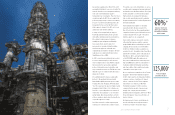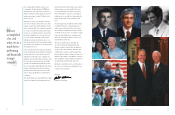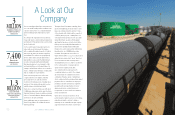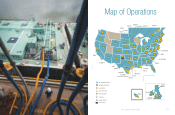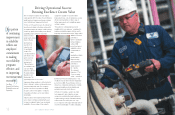Valero 2013 Annual Report Download - page 13
Download and view the complete annual report
Please find page 13 of the 2013 Valero annual report below. You can navigate through the pages in the report by either clicking on the pages listed below, or by using the keyword search tool below to find specific information within the annual report.
22 23
2013 SUMMARY ANNUAL REPORT 2013 SUMMARY ANNUAL REPORT
Valero is making significant infrastructure
investments to both process and move more
domestic crude oil, thanks to an unprecedented
boom in shale oil production primarily in Texas and
North Dakota.
“The growth in U.S. and Canadian shale
development provides a lower-cost North American
resource advantage that should continue to
provide strong supply growth in
crude oil, but also natural gas
and natural gas liquids (NGLs),”
said Gary Simmons, Senior Vice
President-Supply,
International Operations and
Systems Optimization.
Valero is making a number of
investments to capitalize on
these resource advantages,
specifically to process more
domestic light crude oil, and
to pursue natural gas and NGL
upgrading projects that bolt onto existing assets.
The Eagle Ford and Permian formations in Texas,
and the Bakken shale in North Dakota, produce
light crude.
The company has raised its capacity to process
light crude oil to approximately 55 percent of
its current slate, with about 75 percent of that
capacity concentrated at its Gulf Coast and
Mid-Continent refineries. In fact, the Gulf Coast
refineries no longer are importing light crude oil
from overseas.
Valero has a number of expansion projects
planned to process more of the light crude,
including:
•Acrude-unitexpansionofapproximately
25,000 barrels per day at the McKee refinery
in Texas, projected for the first half of 2015,
at an estimated cost of $60 million
•Twonewcrudeoiltoppingunits–an
expansion of 90,000 barrels per day at the
Houston refinery for roughly $400 million,
and of 70,000 barrels per day at Corpus
Christi for about $350 million – expected to
be on-line in early 2016
More projects are being evaluated at the Port
Arthur, Texas, and Meraux, La., refineries.
Valero additionally is investing to transport and
receive more North American crude. The company
has purchased more than 5,300
rail cars, which began delivery in
late 2012 and will continue to arrive
through second-quarter 2015.
Approximately 2,000 cars had been
received through February 2014.
About 20,000 barrels per day of
rail unloading capacity has been
added at the St. Charles refinery
in Louisiana, and another 70,000
barrels per day of capacity is
expected to be ready at the Port
Arthur refinery in the fourth quarter
of 2014. The Benicia refinery in California is
expected to receive 30,000 to 50,000 barrels per
day of crude by rail in first-quarter 2015.
Near the end of 2014, the Jean Gaulin refinery
in Quebec is projected to receive all of its crude
oil from North America, replacing costlier foreign
imports. Crude-by-rail capacity at the refinery had
rapidly grown to 60,000 barrels per day at the end
of 2013. The refinery also is receiving light crude
from the U.S. Gulf Coast by ship, on lower-cost,
foreign-flagged vessels. The refinery will round
out its domestic crude supply by pipeline when
Enbridge Inc.’s Line 9B pipeline reversal from
North Westover, Ontario, to Montreal occurs in late
2014.
Lower-cost North American natural gas additionally
provides competitive advantages and upgrading
opportunities. Natural gas is a feedstock that is
converted to hydrogen to provide desulfurization
and liquid volume expansion.
Driving Domestic Oil Processing:
Resource Advantages Spur Success
e growth
in U.S. and
Canadian shale
development
provides
a lower-
cost North
American
resource
advantage
that should
continue to
provide strong
supply growth
in crude oil,
but also natural
gas and natural
gas liquids.
Gary Simmons
Senior Vice President-
Supply, International
Operations and
Systems Optimization




